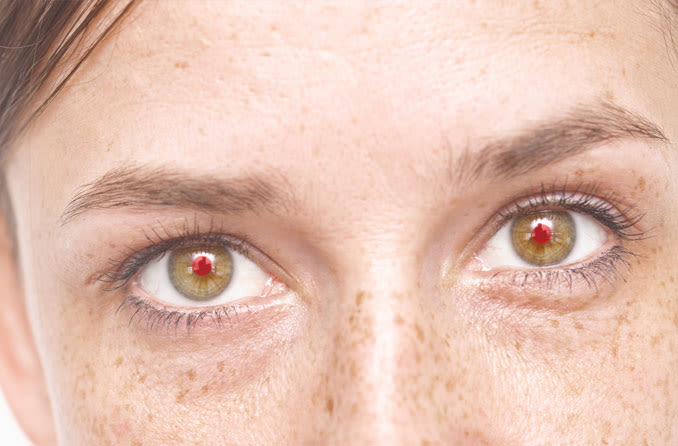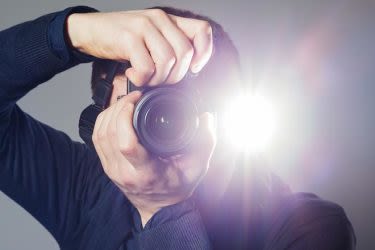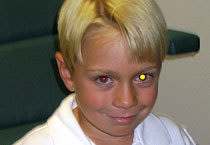How to get rid of the red eye effect in photos

Tired of photographs being ruined because the eyes of someone in the photo appear bright red?
This article answers common questions about this “red-eye effect,” and what you can do to avoid it.
What causes red eyes in photographs?
Eyes will appear red in photographs when a camera captures light reflecting from your subject’s retinas when the flash is used at night or in dim lighting.
Light rays travel through the cornea and pupil of the eye to focus on the retina (a layer of light-detecting cells at the back of the eye).
When a camera flash goes off, the pupils of your subject's eyes don't have time to constrict to reduce the amount of light entering their eyes. Therefore, a large burst of light reaches the retina, reflects back, and is captured on film.
The red colour is due to the rich blood supply of the choroid, a layer of connective tissue at the back of the eye that nourishes the retina and gives it its normal red colour.

The more distance between the lens and the flash, the less likely you will have red eyes in pictures.
Does disabling the flash eliminate this red-eye effect?
Yes, if there is enough ambient light to take photographs without using the flash, you'll avoid red eyes in photos.
Are there other ways to prevent red eyes in photos?
Besides disabling the flash on your camera, here are other ways to prevent red eyes in photos:
Don't look directly at the camera
Tell your subjects to look slightly away from the lens, so their eyes won't catch the flash at a direct angle. This will reduce the likelihood of red eyes in pictures.
Make the room brighter
The darker the environment, the more dilated the subject's pupils become, which increases the likelihood of red-eye effects in photos. Increasing ambient light levels can help eliminate red eyes.
Turn on your camera’s 'red-eye reduction' feature
Most modern cameras have this feature, which emits short flashes of light in quick succession before the camera actually takes the picture. These light flashes constrict your subject’s pupils, reducing how much light reflects back from the retina.
Use an external flash
This method doesn't work for cameras with built-in flashes, but if you have a camera that supports the use of an external flash, moving the flash unit farther away from the camera lens will prevent light from reflecting directly back into the lens and eliminate the red eye problem.
Make sure your subjects aren't drunk!
Too much alcohol slows reaction time. But did you know it also affects the response time of your pupils? Red eyes occur more often in photographs if your subject is intoxicated, because their pupils won't constrict fast enough to reduce the amount of light that reflects back from the retina.
Removing red eyes from photos
If you have photos that have someone with red eyes in them, here are a few ways to remove the red-eye effect:
Digital photos
If you are using a digital camera, you can upload the photos to your computer and then edit out the offending red eyes with the "red eye removal tool" in a picture-editing program. Some applications have a "drag and drop" feature where you can pick up a colour from the iris of the eye and place it over the parts of the eyes appearing red; other programs automatically correct the offending red eye for you.
Smartphone photos
Apps are available for your smartphone (all types) that allow you to fix red eyes in photos. Basically, if a face is detected in a photo and there's red eye, you can use an auto-enhance tool to remove the redness and make the subject's eyes appear more natural. Also, most image-editing apps have a tool that allows you to manually fix red eye problems in smartphone photos.
Printed photos
If you've developed your camera film and notice red eyes in a photograph, you can remove the effect a special red-eye remover pen. You also can scan the photo to your computer and use a photo-editing program to remove the red-eye effect.
Why are only some people in a group photo affected by the red-eye effect?
A number of factors can account for this. The most likely reason is that the people without the red-eye effect were not looking directly at the camera or they were not in direct line with the camera's built-in flash.
What does it mean if you have only one red eye in a photo?
Having only one eye appear red in a photo usually means only one of your subject's eyes (the one that appears red) was staring directly at the camera lens, while the other eye was positioned at a slightly different angle.
Rarely, red eye in only one eye may indicate an eye disease such as a tumour or cataract. Another possibility is strabismus, which is a misalignment of the eyes.
If you or a family member consistently have only one eye that appears red in photos, consult your optician.
I have red eyes in every photo! Is there something wrong with me?
Chances are, the reason you have red eyes in every photo is that you tend to stare directly into the camera lens when you pose for pictures, enabling the light to reflect from your retinas directly back into the camera.
In future photos, simply change your direction of gaze slightly to the left or right of the camera to eliminate the red-eye effect.
It’s possible you have pupils that are relatively large in size. If you have large pupils, you're more likely to have red eyes in pictures. Even with large pupils, however, avoiding looking directly at the camera will reduce the likelihood your eyes will appear red in photos.

A family photo helped reveal this little boy's eye disease. (Image: Megan Webber)
What if one eye is red and the other eye appears bright yellow or white?
A white or yellowish glow, called leukocoria, in one eye could signal a serious eye condition or disease, including cataract, Coats' disease, eye infection or retinal detachment.
A white or yellow reflex (eye shine) could also be a warning sign of a rare but serious childhood cancer called retinoblastoma.
If you notice anything unusual about your child's eyes in photos, consult an optician immediately.
Why do my dog's eyes shine different colours in photos?
White, yellow or green glow reflecting from the eyes of dogs, cats, deer and other animals is caused by a structure in the back of these animals’ eyes called the tapetum lucidum.
The tapetum lucidum is a special reflective layer in the back of many animals' eyes. When light reflects from this layer, it causes the pupils of these animals to glow in a variety of colours.
The tapetum lucidum contributes to the superior night vision of some animals.
Page published on Tuesday, 25 June 2019






